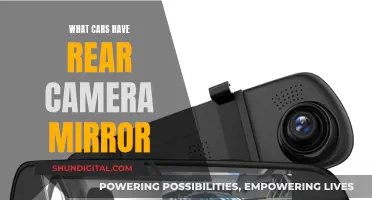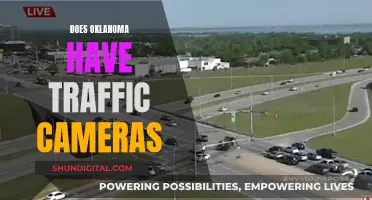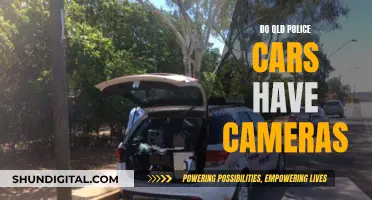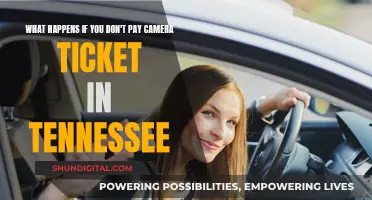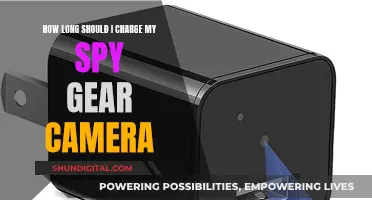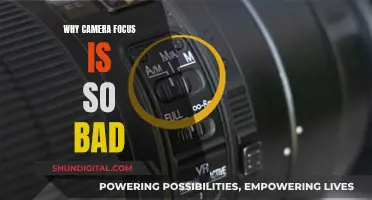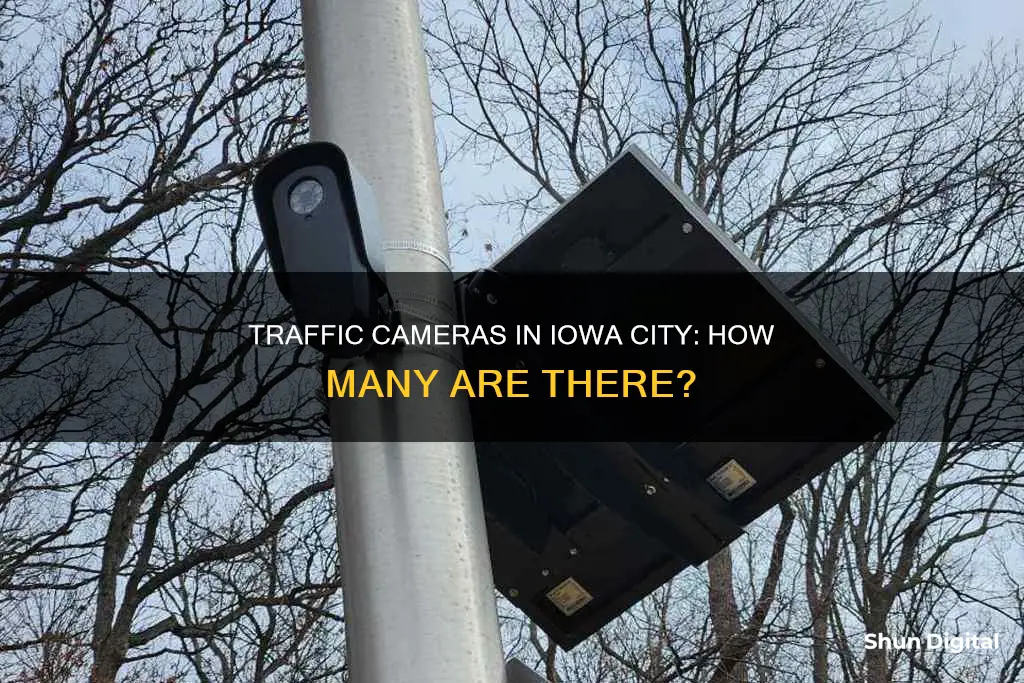
Iowa has recently introduced new laws regarding the use of traffic cameras in the state. The new laws limit how and when cities and counties can use traffic cameras to issue tickets and standardise fines for speeding violations. As of January 2024, at least 25 Iowa cities were operating automated traffic cameras, with 112 cameras counted in 10 cities with definitive data. The new laws require cities to obtain a permit from the Iowa Department of Transportation to deploy automated traffic cameras, with existing cameras allowed to remain in use until October 1, 2024, while cities apply for permits. So, while the exact number of traffic cameras in Iowa City is unclear, the new laws will likely result in a reduction in the number of cameras in use across the state.
What You'll Learn

Iowa traffic camera regulations
In 2024, Iowa Governor Kim Reynolds signed a law limiting traffic cameras in the state. The law, House File 2681, places limits on how and when cities and counties can use traffic cameras to issue tickets and standardizes the fines that drivers can receive.
Under the new law, cities and counties seeking to install traffic enforcement cameras must first obtain a permit from the Iowa Department of Transportation (DOT). They must submit a written justification for why the cameras are needed, including records of traffic violations, the severity of collisions, speed data, and alternative methods considered to improve public safety.
The law also sets out several other regulations for the use of traffic cameras:
- Traffic enforcement cameras can only be used to issue tickets when someone is driving more than 10 miles per hour over the speed limit.
- Communities with a population of 20,000 or fewer cannot issue tickets from their cameras but can issue warnings.
- Local governments must place signs at least 500 to 1,000 feet in advance of any traffic cameras, notifying drivers of their presence.
- Individuals ticketed from the cameras can provide evidence that they were not driving at the time, if they provide the name and address of the person who was driving.
- Any stored photos of license plates must be deleted within 30 days unless they are part of an ongoing criminal investigation.
- Communities must submit annual reports by March 1 to the DOT, detailing the number of collisions and citations at camera locations.
The law also standardizes the fines that drivers can receive for speeding violations when ticketed using a traffic camera. The fines range from $75 for driving 11-20 miles per hour above the speed limit up to $500 for driving more than 30 miles per hour over the limit. These fines are doubled for speeding in a work zone.
While the new law limits the use of traffic cameras in Iowa, it stops short of banning them entirely, as some lawmakers had sought. Instead, it aims to regulate their use and ensure that they are deployed in a way that improves traffic safety and protects the rights of drivers.
Charging the Zumimall Camera: A Step-by-Step Guide
You may want to see also

Iowa traffic camera locations
Iowa has recently introduced new regulations for its traffic cameras, limiting how and when cities and counties can use them for ticketing purposes. The new law also standardises fines for speeding violations.
As of January 2024, at least 25 Iowa cities were operating automated traffic cameras, with 112 cameras counted in 10 cities with definitive data. The city of Cedar Rapids operates 15 automated traffic enforcement cameras at nine locations, including on Interstate 380. Other cities with traffic cameras include Davenport, Des Moines, Windsor Heights, Marion, and Iowa City.
Traffic cameras are typically installed at key intersections and school zones, as well as areas with high traffic, a history of accidents, or speeding violations. Some specific locations in Iowa include:
- East 15th Street at East University Avenue
- 2nd Avenue at Euclid Avenue
- 1st Avenue at 10th Street East
- 1st Avenue at 10th Street West
- West Broadway at 35th Street
- West Broadway at 16th Street
- I-380 near the 1st Avenue Bridge
- I-380 at the 42nd Street NE exit
- Kimberly Road near Brady Street
- Welcome Way near 53rd Street
- I-29 near the Sergeant Bluff exit
- Gordon Drive near the Floyd River
How Do Disposable Cameras Work Without Batteries?
You may want to see also

Iowa traffic camera fines
In Iowa, red light and speed cameras are installed in several cities to improve road safety and reduce violations. These cameras are typically placed in high-traffic intersections, school zones, and areas with a history of accidents or speeding.
In 2024, Gov. Kim Reynolds signed a law limiting traffic cameras in Iowa, addressing a long-standing dispute over their use. The new regulations, outlined in House File 2681, standardise fines for speeding violations captured by traffic cameras. The fines are as follows:
- $75 for driving 11-20 mph above the speed limit
- $100 for driving 21-25 mph above the speed limit
- $250 for driving 26-30 mph above the speed limit
- $500 for driving more than 30 mph above the speed limit
These fines double if the speeding occurs in a work zone. For example, driving 11-20 mph over the speed limit in a work zone results in a $150 fine.
The new law also includes several other regulations. Traffic enforcement cameras can only issue tickets when a driver exceeds the speed limit by more than 10 mph. Communities with a population of 20,000 or fewer cannot issue tickets but can give warnings. Signs must be placed at least 500 to 1,000 feet before any traffic cameras to notify drivers of their presence. Those ticketed can provide evidence that they were not driving, but they must provide the name and address of the person who was driving. Any stored photos of license plates must be deleted within 30 days unless they are part of a criminal investigation.
Cities that used traffic cameras before January 1, 2024, can continue to operate them while applying for a permit from the Department of Transportation. Cities that began using traffic cameras on or after January 1, 2024, will have to wait until at least July 1, 2026, to receive a permit.
Understanding Your Camera's Drive Mode Dial
You may want to see also

Iowa cities with traffic cameras
Iowa's traffic cameras have been a controversial topic, with some lawmakers seeking to ban them, while others want to preserve cities' control over the systems. In 2024, Gov. Kim Reynolds signed a law limiting the use of traffic cameras in the state. This law places restrictions on how and when cities and counties can use these devices to issue tickets and standardizes the fines that drivers must pay.
As of January 2024, at least 25 Iowa cities were operating automated traffic cameras, according to the Legislative Services Agency. While the agency could not determine the exact number of cameras in operation, it counted 112 cameras across 10 Iowa cities with definitive data.
The city of Cedar Rapids, for example, operates 15 automated traffic enforcement cameras at nine locations, including Interstate 380. Other cities with traffic cameras include Davenport, Des Moines, and Windsor Heights.
The new state law requires local governments to obtain a permit from the Iowa Department of Transportation to deploy automated traffic cameras for speed limit or red-light violations. Cities must provide data justifying the need for each camera, including traffic and crash figures. The Iowa DOT will then decide whether a camera is appropriate and necessary for each location.
The law also sets out specific regulations for the use of traffic cameras and the fines associated with citations. For instance, traffic enforcement cameras can only be used to issue tickets when someone is driving more than 10 miles per hour over the speed limit. Additionally, communities with a population of 20,000 or fewer cannot issue tickets from their cameras but can still issue warnings.
Reversing Cameras in Small Cars: Which Models Have Them?
You may want to see also

Iowa traffic camera statistics
Traffic cameras are a controversial topic in Iowa, with some lawmakers seeking to ban them, while others aim to preserve cities' control over their use. In 2024, Gov. Kim Reynolds signed a law limiting the use of traffic cameras in the state and standardizing the fines that drivers can receive from tickets issued by these devices. This new law, House File 2681, was passed with broad bipartisan support.
The law imposes several regulations on the use of traffic cameras. Cities and counties must now obtain a permit from the Iowa Department of Transportation (DOT) to deploy automated traffic cameras. They must submit a written justification, including records of traffic violations, collision severity, speed data, and alternative methods considered to improve public safety. The Iowa DOT will determine the necessity of each camera and whether it is the least restrictive means to address traffic safety at a given location.
Under the new law, traffic enforcement cameras can only issue tickets when a driver is travelling more than 10 miles per hour over the speed limit. Communities with a population of 20,000 or fewer cannot issue tickets, although they can still give warnings. Local governments must also place signs notifying drivers of the presence of traffic cameras, and any stored photos of license plates must be deleted within 30 days unless they are part of a criminal investigation.
The specific fines for speeding violations have been standardized as follows:
- $75 for driving 11-20 mph over the limit
- $100 for driving 21-25 mph over the limit
- $250 for driving 26-30 mph over the limit
- $500 for driving more than 30 mph over the limit
These fines are doubled for speeding violations in work or construction zones.
According to the Legislative Services Agency, as of January 2024, at least 25 Iowa cities were operating automated traffic cameras, with 112 cameras counted in 10 cities with definitive data. However, the exact number of cameras in the state is unknown. Cedar Rapids, with 15 cameras at nine locations, and Des Moines, are among the cities with the most active traffic cameras.
Deleting Adobe Camera Raw Cache: What You Need to Know
You may want to see also


